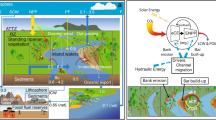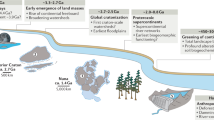Abstract
Meandering rivers are diagnostic landforms of hydrologically active planets, and their migration regulates the continental component of biogeochemical cycles that stabilize climate and allow for life on Earth. The rise of river meanders on Earth has been linked to riverbank stabilization driven by the Palaeozoic evolution of plant life about 440 million years ago. Here we provide a fundamental test for this hypothesis using a global analysis of active meander migrations that includes previously ignored unvegetated rivers from the arid interiors of modern continents. When normalized by channel size, unvegetated meanders universally migrate an order of magnitude faster than vegetated ones. While providing irrefutable evidence that vegetation is not required for meander formation, we demonstrate how profoundly vegetation transformed the pace of change for Earth’s landscapes, and we at last offer a mechanistic explanation for the radically distinct stratigraphic records of barren and vegetated rivers. We posit that the migration slowdown driven by the rise of land plants dramatically impacted biogeochemical fluxes and rendered Earth’s landscapes even more hospitable to life. Therefore, the tenfold faster migration of unvegetated rivers may be key to deciphering the environments of barren worlds such as early Earth and Mars.
This is a preview of subscription content, access via your institution
Access options
Access Nature and 54 other Nature Portfolio journals
Get Nature+, our best-value online-access subscription
$29.99 / 30 days
cancel any time
Subscribe to this journal
Receive 12 print issues and online access
$259.00 per year
only $21.58 per issue
Buy this article
- Purchase on Springer Link
- Instant access to full article PDF
Prices may be subject to local taxes which are calculated during checkout



Similar content being viewed by others
Data availability
The authors declare that all data supporting the finding of this study are available within the article and its Supplementary Information files. The latter include a supporting discussion on flood-recurrence intervals, aggradation versus subsidence rates in alluvial basins and their relations to the dimensions of deposited channel bodies and the storage time of floodplain sediment and POC.
References
Branagan, D. in The Origins of Geology in Italy Vol. 411 (eds Vai, G. B. & Caldwell, W. G. E.) 31–42 (Geological Society of America, 2006).
Malin, M. C. & Edgett, K. S. Evidence for persistent flow and aqueous sedimentation on early Mars. Science 302, 1931–1934 (2003).
Lorenz, R. D. et al. Fluvial channels on Titan: initial Cassini RADAR observations. Planet. Space Sci. 56, 1132–1144 (2008).
Jackson, R. G. II Depositional model of point bars in the Lower Wabash River. J. Sediment. Pet. 46, 579–594 (1976).
Bathurst, J. C., Thorne, C. R. & Hey, R. D. Direct measurements of secondary currents in river bends. Nature 269, 504–506 (1977).
Schumm, S. A. & Khan, H. R. Experimental study of channel patterns. Geol. Soc. Am. Bull. 83, 1755–1770 (1972).
Johannesson, H. & Parker, G. in River Meandering Vol. 112 (eds Ikeda, S. & Parker, G.) 181–213 (Water Resources Monographs, 1989).
Schumm, S. A. Speculations concerning paleohydrologic controls of terrestrial sedimentation. Geol. Soc. Am. Bull. 79, 1573–1588 (1968).
Lovelock, J. E. & Margulis, L. Atmospheric homeostasis by and for the biosphere: the Gaia hypothesis. Tellus 26, 2–10 (1974).
Davies, N. S. & Gibling, M. R. Cambrian to Devonian evolution of alluvial systems: the sedimentological impact of the earliest land plants. Earth Sci. Rev. 98, 171–200 (2010).
Fuller, A. O. A contribution to the conceptual modelling of pre-Devonian fluvial systems. South Afr. J. Geol. 88, 189–194 (1985).
Li, J. et al. An ephemeral meandering river system: sediment dispersal processes in the Río Colorado, Southern Altiplano Plateau, Bolivia. Z. Geomorphol. 59, 301–317 (2015).
Ielpi, A. Morphodynamics of meandering streams devoid of plant life: Amargosa River, Death Valley, California. Geol. Soc. Am. Bull. 131, 782–802 (2019).
Long, D. F. G. in From River to Rock Record: The Preservation of Fluvial Sediments and Their Subsequent Interpretation Vol. 97 (eds. Davidson, S. K. et al.) 37–61 (SEPM Society for Sedimentary Geology, 2011).
Santos, M. G. M. & Owen, G. Heterolithic meandering-channel deposits from the Neoproterozoic of NW Scotland: implications for palaeogeographic reconstructions of Precambrian sedimentary environments. Precambrian Res. 272, 226–243 (2016).
Ielpi, A., Rainbird, R. H., Ventra, D. & Ghinassi, M. Morphometric convergence between Proterozoic and post-vegetation rivers. Nat. Commun. 8, 15250 (2017).
Ielpi, A. River functioning prior to the rise of land plants: a uniformitarian outlook. Terra Nova 30, 341–349 (2018).
Lauer, J. W. & Parker, G. Modeling framework for sediment deposition, storage, and evacuation in the floodplain of a meandering river: theory. Water Resour. Res. 44, W04425 (2008).
Galy, V., Peucker-Ehrenbrink, B. & Eglington, T. Global carbon export from the terrestrial biosphere controlled by erosion. Nature 521, 204–207 (2015).
Torres, M. A. et al. Model prediction of long-lived storage of organic carbon in river deposits. Earth Surf. Dynam 5, 711–730 (2017).
Ganti, V., Whittaker, A. C., Lamb, M. P. & Fischer, W. W. Low-gradient, single-threaded rivers prior to greening of the continents. Proc. Natl Acad. Sci. USA 116, 11652–11657 (2019).
Aalto, R., Lauer, J. W. & Dietrich, W. E. Spatial and temporal dynamics of sediment accumulation and exchange along Strickland River floodplains (Papua New Guinea) over decadal-to-centennial timescales. J. Geophys. Res. 113, F01S04 (2008).
Smith, D. G. Effect of vegetation on lateral migration of anastomosed channels of a glacier meltwater river. Geol. Soc. Am. Bull. 87, 857–860 (1976).
Limaye, A. B. & Lamb, M. P. Numerical simulations of bedrock valley evolution by meandering rivers with variable bank material. J. Geophys. Res. Earth 119, 927–950 (2014).
McLelland, S. J. et al. in Fluvial Sedimentology VI Vol. 28 (eds Smith, N. D. & Rogers, J.) 43–57 (International Association of Sedimentologists, 1999).
Jerolmack, D. J. & Mohrig, D. Conditions for branching in depositional rivers. Geology 35, 463–466 (2007).
Mohrig, D., Heller, P. L., Paola, C. & Lyons, W. J. Interpreting avulsion process from ancient alluvial sequences: Guadalope–Matarranya system (northern Spain) and Wasatch Formation (western Colorado). Geol. Soc. Am. Bull. 112, 1787–1803 (2000).
Bouchez, J. et al. Oxidation of petrogenic organic carbon in the Amazon floodplain as a source of atmospheric CO2. Geology 38, 255–258 (2010).
Beck, H. E. et al. Present and future Köppen–Geiger climate classification maps at 1-km resolution. Sci. Rep. 5, 180214 (2018).
Dunne, K. B. J. & Jerolmack, D. J. Evidence of, and a proposed explanation for, bimodal transport states in alluvial rivers. Earth Surf. Dynam. 6, 583–594 (2018).
Gran, K. & Paola, C. Riparian vegetation controls on braided stream dynamics. Water Resour. Res. 37, 3275–3283 (2001).
Tal, M. & Paola, C. Dynamic single-thread channels maintained by the interaction of flow and vegetation. Geology 35, 347–350 (2007).
Leopold, L. B. & Wolman, M. G. River Channel Patterns: Braided, Meandering, and Straight US Geological Survey Professional Paper 282-B (US Government Printing Office, 1957).
Zimmerman, R. C., Goodlett, J. C. & Comer, G. H. in Symposium on River Morphology Vol. 75, 255–275 (International Association of Hydrological Sciences, 1967).
Church, M. Geomorphic thresholds in riverine landscapes. Freshw. Biol. 47, 541–557 (2002).
Eaton, B. C. & Giles, T. R. Assessing the effect of vegetation-related bank strength on channel morphology and stability in gravel-bed streams using numerical models. Earth Surf. Process. Landf. 34, 712–724 (2009).
Ielpi, A. & Lapôtre, M. G. A. Biotic forcing militates against river meandering in the Bonneville Basin of Utah. Sedimentology 66, 1896–1929 (2019).
Ielpi, A. & Lapôtre, M. G. A. Barren meandering streams in the modern Toiyabe Basin of Nevada, U.S.A., and their relevance to the study of the pre-vegetation rock record. J. Sediment. Res. 89, 399–415 (2019).
Sylvester, Z., Durkin, P. & Covault, J. A. High curvatures drive river meandering. Geology 47, 263–266 (2019).
Brice, J. C. Channel Patterns and Terraces of the Loup Rivers in Nebraska Geological Survey Professional Paper 422-D (US Government Printing Office, 1964).
Lehner, B., Verdin, K. & Jarvis, A. New global hydrography derived from spaceborne elevation data. Eos 89, 93–94 (2008).
Harvard WorldMap Database (Center for Geographic Analysis at Harvard Univ., accessed 15 January 2019); http://worldmap.harvard.edu/
Farr, T. G. et al. The shuttle radar topography mission. Rev. Geophys. 45, RG2004 (2007).
Acknowledgements
This research was supported by a Discovery Grant from the Natural Sciences and Engineering Research Council of Canada (A.I.) and by the John Harvard Distinguished Science Fellows Program within the FAS Division of Science of Harvard University (M.G.A.L.).
Author information
Authors and Affiliations
Contributions
A.I. and M.G.A.L. jointly conceived the study and conducted fieldwork in the Great Basin of the western United States, and they equally contributed to the preparation of the manuscript. The morphometric dataset of meander migrations was compiled by A.I.
Corresponding author
Ethics declarations
Competing interests
The authors declare no competing interests.
Additional information
Peer review information Primary Handling Editor(s): Melissa Plail; Xujia Jiang.
Publisher’s note Springer Nature remains neutral with regard to jurisdictional claims in published maps and institutional affiliations.
Supplementary information
Supplementary Information
Supplementary descriptions, Figs. 1–7 and Tables 1–4.
Supplementary Data 1
Migration rates from modern unvegetated channels.
Supplementary Data 2
Migration rates from modern vegetated channels.
Supplementary Data 3
Geographical coordinates for the river reaches measured in this study.
Rights and permissions
About this article
Cite this article
Ielpi, A., Lapôtre, M.G.A. A tenfold slowdown in river meander migration driven by plant life. Nat. Geosci. 13, 82–86 (2020). https://doi.org/10.1038/s41561-019-0491-7
Received:
Accepted:
Published:
Issue Date:
DOI: https://doi.org/10.1038/s41561-019-0491-7
This article is cited by
-
Vegetation enhances curvature-driven dynamics in meandering rivers
Nature Communications (2024)
-
Lowland river sinuosity on Earth and Mars set by the pace of meandering and avulsion
Nature Geoscience (2023)
-
Mineral evolution facilitated Earth’s oxidation
Communications Earth & Environment (2023)
-
Lateral river erosion impacts the preservation of Neolithic enclosures in alluvial plains
Scientific Reports (2023)
-
Large sinuous rivers are slowing down in a warming Arctic
Nature Climate Change (2023)



